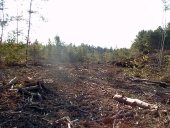This may end up as a longish
thread, as it will span several years (and may take that long again for me to locate and organize photos), so stay tuned for more and better pictures.
But first, the backstory. Bought the property in October 2014 - hard to believe it is coming up on 5 years now - and I call it my stump farm. It is a large piece of
land with an amazing amount of diversity in soil, flora, fauna, micro-climates, springs, a large creek. In short, my slice of heaven. But it was clear-cut 4 years before I bought it, and while I curse those who would do such a thing, felling grandfather oaks for a quick buck, in truth it is the only reason I could afford to buy such a piece of land, and it is also responsible for the fantastic regeneration and explosion of diverse plants, flowers, insects, butterflies, birds, etc... Thanks to the creek and the springs, the loggers had to preserve a good bit of the older growth as buffer, which I enjoy every day on my walks through the woods. For those looking to buy land, clearcut property is land at its ugliest, but it is also land at its cheapest, and if you buy some, it will amaze you with how quickly it regenerates, but thats a topic for another thread another day. One downside worth noting is that if you do buy clearcut land, you own land that is full of (a) stumps and (b) tons of slash (branches and logs).
When I first bought the land, I was only there on weekends, and I was just itching to get some
apple trees in the ground. Because as we all know, the best time to plant an
apple tree is five years ago. The second best time to plant one is today. So I found some southern heritage apple trees for sale
online, and as I wandered the interweb trying to figure out how to keep them alive without being able to
water them on a regular basis, I stumbled across...PERMIES! Yes, that was my introduction to
permaculture, and more specifically, hugelculture. Now, I am sure I made and am making numerous errors in planning, design and execution along the way, but if someone learns from my mistakes, so much the better. What I will try to do here is document my
hugel journey over the last five years. So often we see early stages, but never see how things turned out down the line. This will sorta be the thread that provides a longer term look at hugels in action. I say sorta, because my weekend farming efforts left plenty to be desired. Things so quickly get away from me and out of hand, and as anyone who has done it or is doing it knows, there are so many fun things to do that taking pictures and writing about it quickly falls to the bottom of the priority list.
My thought process was (a) I want to plant some apple trees; (b) I have no running water or electricity; (c) I have gobs of stumps in the ground and slash covering it and (d) I really want to keep my apple trees from drying out and dying when I am away. And so the lightbulb went on, and the problem became the solution. What if I build some hugels (and please note that I am using that term loosely) sorta on contour using the existing stumps and slash, and let the hugels sponge up moisture when it rains, and slowly nourish my baby apple whips.
So that's what I attempted - 6 apple trees went into the ground as skinny whips, were nourished by the hugels, and all are still alive today. I was also able to grow veggies on the hugels as bonus, and have had decent success again with no watering required. More pictures to follow.

 6
6




 4
4










 4
4




 6
6














